An interesting article by David Buller about the problems of Evolutionary Psychology - from Scientific American. As the title of the article indicates, Buller describes 4 major fallacies of Evolutionary Psychology of the Tooby and Cosmides variety. I basically agree with his points. Evolutionary psychology has always had the benefit of fitting under the evolutionary science umbrella (vs. other kinds of social science explanations) but really only produces popular stories that are somewhat plausible (though Buller points out why they are less than plausible when examined more closely). At any rate, I recommend the article.
Thursday, December 25, 2008
Tuesday, December 16, 2008
Quantitative Archaeology Wiki [Quantitative Archaeology Wiki]
Quantitative Archaeology Wiki provides a nice summary of basic statistics done in using the free platform 'R'. If you don't know R, you should - while may be not a GUI pull-down menu kind of stats package, you can literally do anything with it and do it easily (and repeatedly). And its free!
The examples shown on the wiki come from Mike Fletcher and Gary Lock's book
Digging Numbers (ISBN 978-0947816698).
Tuesday, December 9, 2008
Synth'd
My experiments with Photosynths and extracting point clouds has been listed in the Photosynth blog: http://blogs.msdn.com/photosynth/archive/2008/11/24/creative-uses-of-photosynth-in-science.aspx . This has resulted in some potentially useful contacts of others working on the same kinds of projects.
Saturday, December 6, 2008
London I
Arrived in London sometime mid-day yesterday (friday) after a reasonable 10 hour flight (if such a flight can ever be reasonable). Took the train and tube to the area around the British Museum and checked into my room. The place, "Royal National" is clearly a backpacker/traveler kind of place since they refused to check me in at 1:15 and when 2:00 rolled around 500 people surged to reception to check in. The place is caverneous but not in the way that might make it seem royal - cavernous in the sense of a maze of tiny halls with 1000s of doors leading into tiny little dorm rooms. There easily could be 20,000 people in this hotel. I'm only here until sunday when I move to the Travistock hotel - but that turns out to be a different side to the same building. Oh well - its clean and they have stewed tomatoes and beans for breakfast. Oh, and free wifi in the pub downstairs (where I am right now).
Im trying to make arrangements to see the original notes of Katherine Routledge that are held at the British Museum. My bloke Ethan was going to set this up but his 1.5 year old daughter keeps him pretty sleepless and busy these days. Ill forge it on my own. First step: barrage the place with emails (its Saturday so I doubt calling will be effective). Fortunately all the email address are on the BM website so I was able send off missives to the entire Oceania staff. Next step on monday will be to do some calling and then maybe some door knocking. For the latter, I am not sure where I would start -- the building is massive and fort like so I might have to wrestle some beefeater to the ground to gain access to the place. I better train.
I'm sitting in the pub right now planning my day. I actually have little to do other than finish the damn presentation for the workshop next week. I have the paper, mind you, but nothing to stand up in front to talk about. Im hoping my copious graphs and figures will serve as the base of that talk. So a little later Ill probably do something with that. Until then, I dunno - perhaps a bitter or a tall glass of some obscure cider. They seems to have all the best cider behind the bar in fridges - in bottles. I suppose this is how they are fermented - in the bottle. Well, maybe - anyways, got to get me some of that. Also a scone. With clotted cream (cream tea, Ethan tells me).
At the same time I need to ignore the raft of email that I got that describes the newest offense by the cultural anthropologists to archaeology - this time a vote to prohibit us from teaching graduate students. Bizarre. I guess we must be too good. or something. Also they continue to drag their feet on the BA - no vote, no discussion, no movement. I know they want me to go ahead and leave CSULB - Ive been told as much - but at some point, what is too much? Mmmm... that bitter looks good right about now -- its kind of 11AM...
London II
I'm in a pub. Above the bar are a set of tvs tuned to the same station. I think its about sports and 'football' - its hard to tell -- the picture is focused on a middle aged man who yells a lot and other than the changing volume of the announcers voice there isnt much going on. There are some statistics and tables but they mean nothing. I cannot understand a word they guy is saying. But it's loud. It's like the worst of radio and TV put together. Do they just not get the idea that with TV you can watch the game itself and not have to focus on the announcer? Seems odd. And loud. I can see my irish cider rattle.
I went to the British Museum today to visit the basalt moai that they stole from the island some years back.  I took a bunch of photos to generate a photosynth -- this is now processing while I quaff this rather tasty cider (Magners). While at the museum, I ran into Fraser Neiman who is in London to give a paper at the CECD at UCL.
I took a bunch of photos to generate a photosynth -- this is now processing while I quaff this rather tasty cider (Magners). While at the museum, I ran into Fraser Neiman who is in London to give a paper at the CECD at UCL.
Moai Photosynth: http://photosynth.net/view.aspx?cid=FD6DC949-A673-4AD8-82A9-F3968BFE569D
I also took a bunch of photos of the crystal skull that is housed in the British Museum -- until recently it was reported to have been "Aztec" but recent analyses of the cut marks show the tell tale sign of mechanical saws. Crap like the recent Indiana Jones movie...
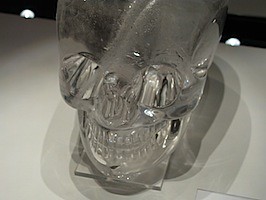
Thursday, December 4, 2008
London
Well, I am off to London this afternoon to participate in a workshop on "Cultural and linguistic diversity" at the AHRC Centre for the Evolution of Cultural Diversity.
My paper, coauthored with Mark Madsen is "Networks, frequency seriation and models of cultural transmission." I'll have an online draft of that paper up shortly if anyone is interested. The workshop is a small affair - held outside of London at the Missenden Abbey Conference Centre (www.missendenabbey.co.uk). The place is sort of isolated in a manor type fair with only 16-17 or so participants. The "usual" crowd is there for these kinds of affairs O'Brien, Collard, Cochrane, Tehrani, Peter Jordan Mace - but also Rob Boyd, Russell Gray, Daniel Nettle (who will apparently be a disembodied head in a Skype link [could we all do that? a gathering of monitors?), John Nerbonne, Fiona Jordan, Charles Nunn and some others who I don't know as well.
 Seems like a good place to hang out in... Ill be online (of course) for much of this trip - return on the 13th.
Seems like a good place to hang out in... Ill be online (of course) for much of this trip - return on the 13th.
Workshop Programme – Cultural and linguistic diversity
Wednesday 10th Dec 2008
0845 – 0900 The Organizers Welcome and introduction to the workshop
0900 – 0955 Russell GRAY [Transmission coupling mechanisms: migration/demic expansion]
0955 – 1050 Rob BOYD Transmission coupling mechanisms: cultural group selection (co-authored with Peter Richerson)
1050 - 1115 TEA/COFFEE
1115 – 1210 Daniel NETTLE (by Skype link) Genetic and linguistic diversity: Global distribution and implications for prehistory
1210 – 1305 Paul HEGGARTY Splits or waves? Trees or webs? Network analysis of language change
1400 – 1455 Claire BOWERN Historical linguistics in Australia: (non-) tree-like evolution and its implications
1455 – 1550 John NERBONNE Measuring the diffusion of linguistic change
1620 – 1715 Carl LIPO Networks, frequency seriation and models of cultural transmission (co-authored with Mark Madsen)
1715 – 1810 James STEELE On demographic interpretations of linguistic and cultural phylogenies (co-authored with Anne Kandler and Aimee Plourde)
Thursday 11th Dec 2008
0900 – 0955 Michael O’BRIEN
Material culture and units of transmission (co-authored with R. Lee Lyman, Alex Mesoudi, and Todd L. Van Pool)
0955 – 1050 Mark COLLARD [Cladistic analysis of cultural traits]
1115 – 1210 Charles NUNN
Simulating trait evolution for cross-cultural comparison (co-authored with Christian Arnold, Luke Matthews, and Monique Borgerhoff Mulder)
1210 – 1305 Ruth MACE Is horizontal transmission really a problem for phylogenetic comparative methods? A simulation study using continuous cultural traits (coauthored with Tom Currie and Simon Greenhill)
1400 – 1455 Jamie TEHRANI Mapping traditions onto populations using trees and jungles: a cophylogenetic approach to cultural inheritance (co-authored with Mark Collard)
1455 – 1550 Ethan COCHRANE Phylogenetic and graph-based network methods in evolutionary anthropology (co-authored with Carl Lipo)
1620 – 1715 Laura FORTUNATO /Fiona JORDAN Your place or mine? A phylogenetic comparative analysis of postmarital residence in Indo-European and Austronesian societies
1715 – 1810 Sean O’NEILL /Peter JORDAN Coupling and de-coupling inherited cultural traits: preliminary investigations of situated social learning
processes as an explanation for cultural diversification on the Northwest Pacific Coast
Thursday, November 27, 2008
Do cultural anthropologists consider archaeology as part of “Anthropology”? – Comments on a new magazine, “Anthropology Now”
Michael E. Smith writes in his blog (Publishing Archaeology) this statement about 4-field anthropology (below). I have long argued that "4-field" anthropology was simply code word for "cultural anthropology" in that the emphasis was always placed on archaeologists to do more what the cultural/linguists do and never the other way around. When was the last time, for example, you heard a 4-field lobbyist argue for more science training in the curriculum for cultural students. It has been a sham of an argument and often, like CSULB, used as a weapon to belittle archaeologists and their curriculum. Smith is lucky in this sense as ASU has assembled the School of Human Evolution and Social Change out of a variety of departments including Anthropology - so he doesn't have to engage in these loaded debates.
Ultimately, the problem is the lack of real debate about what the product of an anthropology degree is supposed to be - there are good reasons to have "4-field" anthropology but they can't simply be a mishmash of crap that the various faculty teach that gets a "4-field" bow stuck on top. But that is for another day's discussion...
Smith's blog:
Since I began teaching in a program that is not called a “Department of Anthropology” three years ago (it’s the “School of Human Evolution and Social Change), I’ve done some thinking on the discipline of anthropology. Many anthropologists in the U.S. have made lots of noise over the years about supporting the notion of “4-fields anthropology”—that is, an academic discipline made up of several subdisciplines: cultural anthropology, biological anthropology, archaeology, and linguistics (Brenton 1996). Of course there are doubters and skeptics, and these may now be in ascendance (Borofsky 2002; Segal, and Yanagisako 2005). In my experience, discourse promoting the 4-fields approach was mainly expressed in order to convince university deans that anthropology is a good thing, that we need more resources, etc.
For a long time, it seemed to me that a major obstacle to achieving some kind of integrated 4-field anthropology was the attitudes of cultural anthropologists. The basic attitude of many cultural anthropologists I have known is that cultural anthropology is the “real” anthropology. Archaeology and physical anthropology are part of this “sacred bundle” of four fields, but they are definitely junior or inferior members of the team. Most departments need them for their undergraduate enrollments and grants, but their practitioners are not really anthropologists in the same sense as cultural anthropologists.
I recently came across information on a new anthropology magazine called Anthropology Now, referred from the excellent blog “Savage Minds: Notes and Queries in [**CULTURAL**] Anthropology” (Oops, I accidentally inserted a word! But wait, it makes the blog name more accurate!) Here is the goal of the magazine:
“ABOUT THE MAGAZINE: Anthropology Now focuses on the ways that anthropological theory and research can inform and affect contemporary public discourse and public policy debates. It offers readers thought-provoking and timely content focused on contemporary issues and debates.”
The editorial statement goes on to say that other subdisciplines already do well in the popular media, but “For a variety of reasons, cultural anthropological approaches to current social issues do not often get incorporated in existing media.”
In case the orientation of the magazine is not clear, look at the Editorial Board. Not surprisingly, all members are cultural anthropologists.
Now I have nothing against a new magazine in (cultural) anthropology. In fact, I think it’s a great idea. But the text on the website just confirms my jaundiced view that cultural anthropologists consider themselves as the “real” anthropologists.
I am of two minds about whether I think this matters or not.
(1) From an intellectual perspective, I would be happy to have cultural anthropologists go ahead and appropriate “anthropology” for themselves. I am an archaeologist, and in my own research I get much more mileage out of literature in urban studies, geography and history than I do from works in cultural anthropology. I disagree VERY STRONGLY with the view that “archaeology is anthropology or it is nothing” (Binford 1962; Gillespie, and Nichols 2003; Willey, and Phillips 1958). That is just a silly statement that made some kind of sense back in the 1950s, but is completely off base today.
(2) From a professional perspective, however, U.S. universities are stuck with anthropology as a discipline. If it splits up into factions, this has very real negative consequences for the research and teaching of all concerned. Anyone in a university knows that there is strength in numbers and factionalism is typically punished by deans. Even when an intellectual case was made for splitting anthropology into two departments at Stanford University, they ended up merged again by top-down fiat (with little or no consultation with faculty). So like it or not, U.S. anthropology departments in U.S. universities are stuck with four fields (or as many of them as a small program can provide).
Sorry to ramble like this. I wish the new magazine best of luck. We really do need something like this. But reading the web site brought back some old resentment about the attitudes of cultural anthropologists toward archaeologists. But now that I teach in a “program formerly known as anthropology,” I don’t need to worry about such things myself. It has been intellectually liberating to be able to concentrate on my research and have lots of diverse colleagues (anthropologists and others) to interact and cooperate with. My courses, however, are still labeled “Anthropology,” which is just fine.
References:
Binford, Lewis R. (1962) Archaeology as Anthropology. American Antiquity 28:217-225.
Borofsky, Robert (2002) THE FOUR SUBFIELDS: Anthropologists as Mythmakers. American Anthropologist 104:463-480.
Brenton, Barrett P. (1996) Four-Field Approach. In Encyclopedia of Cultural Anthropology, edited by David Levinson and Melvin Ember, pp. 508-510. vol. 2. Henry Holt, New York.
Gillespie, Susan D. and Deborah L. Nichols (editors) (2003) Archaeology is Anthropology. Archaeological Papers vol. 13. American Anthropological Association, Washington, DC.
Segal, Daniel A. and Sylvia J. Yanagisako (editors) (2005) Unwrapping the Sacred Bundle: Reflections on the Disciplining of Anthropology. Duke University Press, Durham, NC.
Willey, Gordon R. and Philip Phillips (1958) Method and Theory in American Archaeology. University of Chicago Press, Chicago.
[From Do cultural anthropologists consider archaeology as part of “Anthropology”? – Comments on a new magazine, “Anthropology Now”]
Wednesday, November 26, 2008
Survey and Resectioning - Online and on the phone
I came across this website from the University of Portsmith Department of Civil Engineering today that covering many of the details about engineering surveying: http://www.civl.port.ac.uk/survey/ The site includes a series of PowerPoint presentations on a variety of essential archaeological field skills (e.g., leveling, setting up a theodolite, theodolite errors, converting rectangular to polar coordinates, etc.). Of particular interest is a Java based "General Purpose Angular Resection Program." As anyone who has taken my Archaeological Field Research Design class will know, resectioning is the best way to establish the position of survey instrument, yet the calculations can be a pain. Having an applet to do this greatly reduces the chance for calculation blunders.
The applet works on Mac and Windows, though on Mac OS X the menus for the applet appear on the menu bar not in the the little applet windows (so user beware). Below is a little screen shot of the input screen for the applet.

If you don't like the applet version of this program, you might try this browser based version:
http://www.spatialreference.co.za/Resection.asp
or the cell phone version (iphone!):
http://www.spatialreference.co.za/cell_Index.asp
More resectioning information:
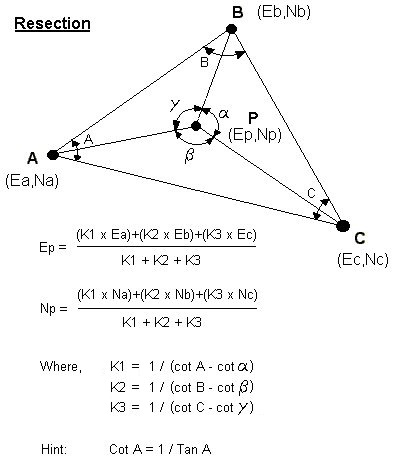
Thursday, November 20, 2008
Science, Empiricism, and the New Archaeology
For my M&T Students out there, you might check out: http://scienceblogs.com/aardvarchaeology/2008/10/classifying_an_archaeologist.php Is he correct? Why? Why not?
Topography generation through photosynth'd blimp photos
The potential of using point clouds generated from relatively uncontrolled blimp photos to establish topography for an area continues to impress me. This summer Chris Lee and I took a series of photos of the "lower town" area of Mycenae, Greece. Using these photos (and photosynth) I was able to generate this surface map (using Surfer). You'll have to check the original photosynth to see the images from this but the reconstruction of the terrain is fairly remarkable. The little grid of circles is formed from the tops of olive trees in a plot. Pretty damn cool.
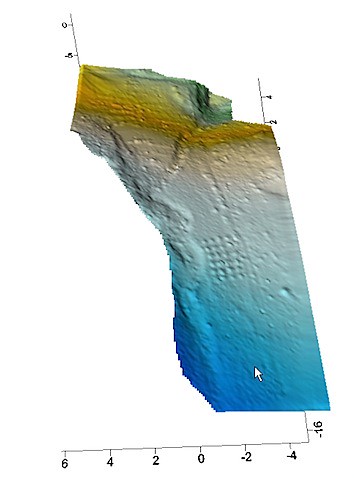
Sunday, November 16, 2008
PSPP
Thursday, November 13, 2008
Photosynth Point Clouds -> Topography?
Using the work of BinaryMillenium I grabbed the bin files that were used to generate the photosynth for one of the Easter Island projects (a series of blimp photographs taken along the slope of Rano Rarku, the statue quarry. That synth can be found here: Rano Raraku - Interior Using the python script, I converted the point cloud data into XYZ data and then used Surfer to generate a surface from those points. My goal was to see how well photosynth might be used to generate topographic maps of landscapes. I had to cut out areas where there were spurious points and areas that were not well covered by the photos. Interestingly, the result is pretty good, though Ill have to do more analysis to compare these results with those from other topographic data generation techniques. Very promising! Best of all, photosynth seems to work best the greater the topographic structure -- cases that are tough (and expensive) to map by transit.
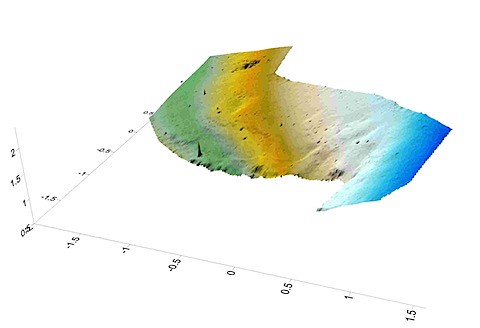
Monday, November 10, 2008
Photosynth and Moai
Here is an example of how to document a moai using photos taken casually over the last few years:
Saturday, October 25, 2008
Blogs... and countdown
With the election just around the corner, I've found myself having a hard time concentrating on much else. I know my fretting isn't going to make a difference but I just can't help worrying what it would feel like if we lost. Holy crap.
Well, as a distractor, I decided to list the archaeology blogs that I tend to follow. I guess this is known as a "blogroll." If anyone knows of other good archaeology blogs to read, let me know.
- Tony Cagle's ArchaeoBlog
- John Hawk's Paleoanthropology Weblog
- GIS for Archaeology and CRM
- Aardvarchaeology (Martin Rundkvist is a big advocator for science based archaeology in the classic "New Archaeology" sense. What he argues is interesting from the point of view of why science and theory are necessary in archaeology)
- Michael Smith's Publishing Archaeology blog
- Jimmy Daniel's Archaeology Graduate Review
Tuesday, October 14, 2008
IIRMES
Been working on implementing the IIRMES web site on the Google Sites platform (now imperative since they have deprecated Google Pages). You can view the new version at http://www.iirmes.org
Another one of RCD
Another photo from Patrick McCutcheon. This one is RCD at Meadowcroft Rockshelter - a stop on a field trip that RCD usually ran during the Society for American Archaeology meetings.
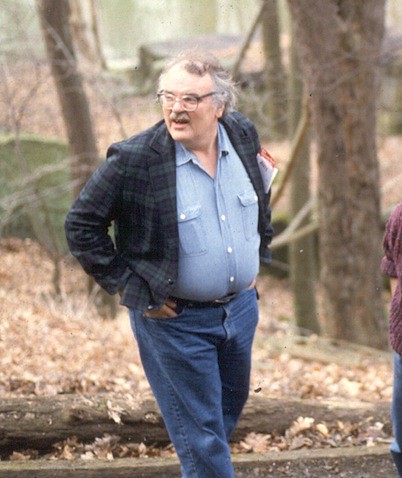
RCD in SEMO
Pat McCutcheon just emailed me an old photo he had of RCD (and Mark Madsen) in the background. It dates to the late 80s, I believe and was taken in one of the fields in southeastern Missouri (Buffalo Slough? Cude Site? Cottonplant?) Mark's outfit has changed - but not RCD's. He wears exactly the same shirt/pants/boots to this day. Ah, those were hopeful times. We certainly know a lot more about doing this archaeology thing now, but we also know that we don't know much and that most folks fight against even trying to know anything.
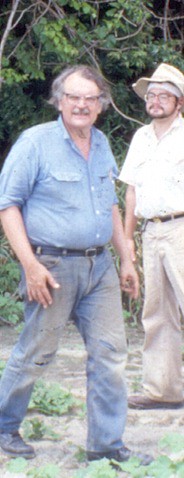
Saturday, October 11, 2008
PSPP 0.6.1
Version 0.6.1 of PSPP ( a bug fix release) was just announced at http://savannah.gnu.org/projects/pspp I created a new set of Mac OS X binaries and put them in an install package so they will end up in /Applications/PSPP (PSPP and PPSPIRE). You can download them here: http://www.csulb.edu/~clipo/papers/pspp/ Windows users should get the binaries at: http://www.gnu.org/software/pspp/get.html
For more info on PSPP, please see: http://www.gnu.org/software/pspp/
Wednesday, October 8, 2008
Stats for Students - PSPP
Monday, October 6, 2008
Stats for Students
While the statistics software package available in most labs around campus is SPSS, the fact that it is not freely distributed to students (an academic version is available to students for $200 -- with your student ID you can buy it online at www.academicsuperstore.com) makes conducting independent research and working at home on stats related projects somewhat difficult. There are a number of free solutions to this problem that you can check out:
(1) For CSULB students, it is possible to freely download (while on the campus network) a copy of Minitab (http://www2.calstate.edu/csp/minitab1.asp). You can only do the download while connected to the CSULB network . This package has a similar interface to SPSS (and is produced by the same company as SPSS). It excels in descriptive stats but also has many other kinds of statistics that you will find in SPSS. It is a windows only product. I use this software myself for simple kinds of analyses.
(2) Systat offers a free version of their stats package to students (MyStat): http://www.systat.com/MystatProducts.aspx I have always liked Systat as a statistics package and use this often as an alternative to SPSS. The free version has a number of limits but generally covers all the statistics that you might use in basic research.
(3) For those who are truly geeky, I highly recommend learning how to use "R" - an open source, free statistic package modeled after S and SPlus. The range of statistics is mindblowing and you will likely find every conceivable statistic and graph that you have ever encountered (from traditional stats, to bioinformatics to spatial stats, to phylogenetics to well, just check out: http://cran.cnr.berkeley.edu/). It works on every platform (windows, mac os x, linux) and is entirely free. You can get it here: http://www.r-project.org/ It is not necessarily for the faint-of-heart when it comes to intuitive interfaces. While there are some project that offer a GUI to R (see: http://www.sciviews.org/_rgui/ I like the Java interface JGR) R works best on the command line and you have to learn its language to run statistics. However, once you do you can virtually do anything (for free!).
An Education in Evolution
Like many universities, the teaching of evolutionary theory at CSULB is front and center in most students' class schedules. Evolution is often taught in classes, but only as a feature of a particular topic. For example, I assume that the classes in biology (and this is actually an assumption since I know there have been reports of faculty who hold creationist beliefs - even in the biology department) teach their subject matter in a way that is consistent with evolution. But there are few (only 1 actually) classes that specifically focus on the details and structure of evolutionary theory. Ironically, that course is not taught by biologists, but by anthropology faculty (physical anthropologists who are part time instructors for biological sciences). I do not believe it is offered very often and given state of our physical anthropologists (moving away from biology and retirement plans) I do not know if it is even taught any more. If it is still taught, that course has minimal influence on the general student body: the set of pre-requisites for the course make it largely an elective option for biology majors -- not a central course that would benefit everyone. One alternative to the biology offering is Kevin MacDonald's course in Psychology (Evolutionary Psychology). MacDonald, though, is a nutball given his interpretive story-telling application of "group evolution" to explain the apparent success of Jewish populations. His connection with Nazis and angering everyone on campus (see also here) means that I don't have much hope that sending a student to one of his classes is going to lead to them learning much about evolutionary theory per se (at least in the way most evolutionary biologists and philosophers of science perceive and use it).
Following David Sloan Wilson's "New Humanities" curriculum, I've started talks with Jeff Davis in Sociology about creating some kind of curricular structure that could link evolutionary offerings in the campus and to provide more of a structured set of courses for everyone. Right now this initiative at CSULB is basically conceptual, but it is a long term goal of mine to find a way of making education in evolution a more central part of every student's degree training. Given the promise of such an effort, I am excited to see it take shape.
One set of resources that might be useful in creating an evolution-focused curriculum are the free online lectures that have been produced by the Cassiopeia Project. Available via iTunes, the videos cover basic science and include lectures on the origins of the universe, complexity, chemistry, physics, quantum mechanics, origins of life, space, relativity, etc. The evolution lectures consist of 10 chapters (ranging from 7 to 17 minutes in length) that can be downloaded and played on any computer equipped with iTunes (i.e., windows or mac). Check 'em out at:
http://www.cassiopeiaproject.com/vid_evolution.php
Saturday, September 27, 2008
Science Writing
I've been nose deep into the book I mentioned earlier -- Richard Dawkins - The Oxford Book of Modern Science Writing - It really is a great set of essays. I could easily imagine teaching an entire semester-long class on the philosophy of science using this book as the central text. The range of notions about the process of science covered in the volume is vast. And from these writing snippets emerges the most intricate and textured account of science that I can imagine. Personally, I find a lot of strength in the work that suggests that the struggle for building a science of human cultural change is worth all the crap that gets lobbied by the dismissive many. I highly recommend this massive tome to anyone wondering whether all the hassle of actually doing science (versus pretending, following rote and tradition, or simply not caring) is worth the effort.
Random Copying
Just came across this blog that references a paper that Jelmer and I did on cultural transmission.:
the blog is by an Estonian researcher in educational technology: Kai Pata. I love the way the web makes these kinds of world-wide, cross-disciplinary connections possible.
Monday, September 22, 2008
Shoggorific and Bad Writing.
Bob O'Hara has some good pointers on bad writing and what to do about it. As an instructor, I see a lot of bad writing. Lots. Much of it comes from a lack of structure and logic to the arguments being made. The sentences themselves may be fine, but the paragraphs are a jumble of ideas that are themselves jumbled together. I've asked some of these students how they know when they have a paragraph and the answers I've gotten range from "when the text gets too long" to "I dunno." Sad. It is as though they were instructed in the mechanics of writing sentences (subject, object, verb) but not how to think and put together a set of ideas into a coherent argument. This kind of bad writing is hard to edit and to grade since the text has no point to it and gives me a blinding headache.
Well, anyways, rather than read my own bad writing on this subject, one might get some good pointers from Bob O'Hara's blog (and man, does he look like an intense dude!).
The Hierarchical Structure of Bad WritingMONDAY, 19 MAY 2008 - 19:53 UTC
This is not, alas, the only way a paper can be badly written. There is a whole hierarchy of levels of str [From The Hierarchical Structure of Bad Writing - Deep Thoughts and Silliness - Bob O'Hara's blog on Nature Network]
Over the past couple of months at Nature Network, there have been a variety of discussions about good writing (these discussions seems to have started shortly after I arrived. Are they trying to tell me something?). One of the early well written papers was commended for the quality of the language, which was simple and clear, and so enjoyable to read. Unfortunately, many papers have sentences that seem to be written with a different aim: to loose the reader in a whirl of syntactic complexities before finally beating them over the head with a dangling modifier, painfully.
Sunday, September 21, 2008
Sabbatical progress
Although I've been a bit too involved in the business of the Anthropology Department due to the continued barrage of de-construction of the archaeology program by Le Chair, I've been slowly achieving some of my sabbatical goals. I'm trying to find a mix of sloth and productivity that allows me to de-rez my brain while at the same time getting some of the fun things done that I've been hankering to do. I guess Im trying to achieve the surfer scientist archetype. So far, I've:
- improved my surfing quite a bit and am finally working on turns and getting more out of the waves. My new Bruce Jones nose-riding long board is seeing much more use and is become my standard board. I still love the SurfTech softtop though.
- have become largely paperless in my office by getting a student to scan-to-pdf all my old articles and materials that used to fill 4 filing cabinets. The key to this is a productive student and the Fujitsu ScanSnap.
- completed and submitted the AD 1680 paper for publication. Also, as of yesterday, the mata'a seriaiton paper. And a paper to Pacific Science.
- finished the wood work project in the living room that I started about 2 years ago.
- am on the brink of the book proposal going out to editors of a dozen publishing houses. Wednesday could be the day.
- ripped apart my office and added a sweet leather couch and coffee table. And am replacing the desk with something less prison-industry looking. Hopefully painting as well.
- created a proposal, marketing material, assessment plan, advising guideline for a BA in Archaeology. Working on getting this passed through the labyrinth of CSULB committees.
- improved percentage of napping to work by nearly 50%
- generating OSL dates for Jelmer and my Brownware Ceramics projects.
I think, though, I still need to increase the surfing/writing percentage by quite a bit.
Saturday, September 20, 2008
Publishing Archaeology: What do we mean by “urban”? Comments on definitions and standards of scholarship
If I was teaching my method and theory class fall (I'm not as I'm on sabbatical - w00t). I would have my students ready this discussion by Michael Smith about the use of terminology in archaeology. I would ask them to write a short essay which asks them to consider "Why is Smith arguing that we need definitions and standards of scholarship in archaeology? What assumptions is he making about the discipline and what it lacks? What else might be contributing to this problem? What solutions are there?." I think most of my ANTH 455/555 (Archaeological Method and Theory I: Formal Theory) students could provide a decent evaluation of what Smith is arguing.
Publishing Archaeology
Monday, September 15, 2008
What do we mean by “urban”? Comments on definitions and standards of scholarship
What do we mean by “urban”? Can archaeologists define terms like this however we please? Should journals go along with idiosyncratic definitions?
In a recent article in the journal Science, Michael Heckenberger et al (2008) use the term “urban” to describe large village settlements in the Xingu region of the Amazon from the late Pre-Columbian period. These sites conform to no published or recognized definition of “urban” that I am aware of. They are far too small to fit the demographic definition of urbanism and they do not have concentrated urban functions required by the functional definition of urbanism (for discussions of these approaches to urban definition, see Smith 1989, 2008b). I sent off a letter to the editor of Science pointing this out, but as usual, the letter was not accepted. You can see it here.
My concern here is with the issue of i [From Publishing Archaeology: What do we mean by “urban”? Comments on definitions and standards of scholarship]
Wednesday, September 17, 2008
Darth Vader vs. Mylos
This weekend old friends from Seattle visited - Syd and Tom with their two boys, Eamon and Mylos. Tom and I got a way in the mornings for a bit of righteous surfing at Seal Beach but most of the weekend was dedicated to the boys. I think the highlight of the whole weekend occurred at Disneyland on Saturday where Mylos battled Darth Vader in the Jedi Academy. Notice Mylos' standard issue jedi cape and green crocs. May the force be with you!

Tuesday, September 16, 2008
Rules for Powerpoint
Many SAA presenters will probably benefit from watching this video on YouTube:
http://in.youtube.com/watch?v=HLpjrHzgSRM
Monday, September 15, 2008
Dr. Jekyll & Mrs. Hyde: Tumult I: The reviewers said what?
Some interesting discussion and observations about the rather random process of manuscript reviews..
Dr. Jekyll & Mrs. Hyde
I'm a postdoc in the biological sciences. I can't decide if I work too much or not enough. I'm married to Dr. Hyde, a fabulous scientist himself, and we're trying, despite some obstacles, to fulfill our Darwinian mandate by having a child or two. The title and pseudonym? One name at work, another at home.
SATURDAY, SEPTEMBER 13, 2008
Tumult I: The reviewers said what?
We finally found out why the official response on my manuscript was "No Editorial Decision At This Time."Turns out, although all three reviews were quite positive, only one of the three reviewers recommended that the manuscript be published in this journal.
The other two recommended the dreaded "Appropriate for a more specialized journal."
I was rather shocked by this news. These (now totally loathed) two reviewers had written things like
" I found the results interesting and intriguing. They represent one of the first serious attempts to understand poogly-plugs at the cellular level. Thus, th [From Dr. Jekyll & Mrs. Hyde: Tumult I: The reviewers said what?]
Saturday, September 6, 2008
In Memory of...
I just received Melissa Brown's edited volume "Explaining Culture Scientifically" which was published by the University of Washington Press. The title of the book is interesting as it is either oxymoronic (given how most anthropologists treat the concept culture) or redundant (given how some of the folks in the book treat culture). Actually, the book contains discussion and examples of both interpretations.
Most interestingly, the books dedication is to the Department of Anthropological Sciences at Stanford University. This now defunct attempt at carving out an anthropology that has distinctly scientific goals, was once a bright example of the different products embedded in the quagmire that is Anthropology. Sadly, much of the engine behind the splitting of the "cultural" and "scientific" anthropology was composed of ill-fitting personalities rather than central principles. Still, for many of us, it was a bold statement. Quite fittingly, the dedication reads:
In memory of
the Department of Anthropological Sciences
at Stanford University
(1998-2007)
with hopes that what might have bloomed there
will find other soil in which to grow.
Here, here.
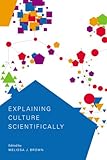
Friday, September 5, 2008
The Tree of Prehistory
Just for kicks - a mosaic of pointed biface photos derived from Kris Wilhelmsen's dissertation research.

Saturday, August 23, 2008
Rano Raraku Synth
I just finished this synth of the statue quarry at Rano Raraku and it has to be one of the coolest things I've ever seen. This uses our blimp photos from 2006. Amazing.
http://photosynth.net/view.aspx?cid=5C835782-4494-4FD4-A0A5-396064007534
Photosynth
Microsoft's new Photosynth is probably one of the coolest bit of technology released by the company in years. It is the product of Microsoft Research and a number of computer scientists from my old alma mater, the University of Washington. Photosynth is a web service that runs through a browser (Windows only for now) that takes stacks of digital photos and merges them into a single, mind-blowlingly cool 3-D arrangement. This is like a 3-dimensional panorama and ideal for photographing subjects where you want an overall view but also the ability to "drill down" to see detail. And Photosynth does this without any preset reference points -- it just takes the pile of photos taken from every crazy angle and matches up points across them all and then produces a 3-dimensional view.
One of the great thing that photosynth does for me is allow me to take blimp photos that have all sorts of yaw, roll, rotation issues and merge them into a single viewable entity. I've been working on this problem for a while - though a wide range of panorama building software (e.g., hugin, Panotools, Autopano, PTAssembler, Tatuk AIC, ArcMAP, ERDAS, DoubleTake, PTGui Pro, and many others). The problem I have is that the photos are so uncontrolled in the blimp in terms of their orientation and distance from subject (much less the issue of the ground topography) that the solutions are not very good and it take a lot of manual work to fix them (if that is even possible). The best solution Ive come up with right now is either Adobe Photoshop CS3 "PhotoMerge" option or PTGui Pro (though DoubleTake is great for a small # of photos). Both seem to work best when the camera has a constant height, the images are sequential, and the topography isnt too lumpy. That's great but it's not easy to achieve.
Photosynth really changes all of this since it is built to examine 3-dimensional things. It does a remarkable job of merging photos together that vary in height, roll, yaw, resolution - easily the best I've ever seen. Now, first thing others ask me about these products is whether or not you can "flatten them" to put into GIS -- that doesn't currently seem possible (it would require more processing to do integrated projection of the aggregate set of images). Ideally, that will be forthcoming but who knows (its free as it is). But as it stands right now, it is a powerful (and easy!) way of visualizing an archaeological landscape with all the detail you can possibly want (depending on your camera and the load on the photosynth servers - it has been pretty popular since being listed on Slashdot).
Here are a couple of the "synths" I've created in the last few days:
Easter Island: Rano Raraku: Rano Raraku - 2
Easter Island: : Akahanga-Easter Island
Guatemala: Cotuzmalguapa
Greece: Mycenae Acropolis
Greece: Mycenae - Lower Town
I'll post more as I create them.
Also, you might want to check how this works and what they have in mind for the future (imagine having a cumulative set of images from everyone in the world for any place) http://phototour.cs.washington.edu/findingpaths/
Thursday, August 14, 2008
Tuesday, August 12, 2008
Type Variety, Systematics, and Scholarship
I recommend that those interested in archaeological systematics read Michael E. Smith's blog on Culbert and Rands' recent "type-variety" article in LAA. http://publishingarchaeology.blogspot.com/2008/08/news-flash-type-variety-classification.html Smith points out a serious failure in the editor/review/writing process in this article that resulted in the failure to cite previous literature that already did what they claimed to do (show that type-variety is flawed and cannot be a "single" classificatory system). The result is an article that is pretty much a "duh" for anyone who has read anything on classification or formal theory in archaeology. Sadly, the way their conclusions are framed - that ceramic complexity is too great -- will lead some to believe that the solution is some numerical technique, a bigger computer, or some new-boffo-annealing-self-organizing-strange-loops - or whatever. This of course misses the point that "ceramic complexity" isn't the problem, its the lack of a problem that is a problem. Without any question, there can't be a way of knowing whether any system of chopping up the world is better than any other. Without questions, what would the "right" (or "correct" or "real") classification look like? How would we know when we found it?
More immediately upsetting is the discipline's acceptance of poor scholarship - for example, literature reviews and relevant citation. When authors who are writing in Latin American Antiquity can't be bothered to read articles from the 70s in American Antiquity (all of which are available on JSTOR) and the reviewers and editors let them get away with that, then there really is a problem.
Monday, August 4, 2008
Science Writing - Compendium assembled by Dawkins
Just bought an edited volume by Richard Dawkins - The Oxford Book of Modern Science Writing - a great compendium of classic science essays from Dobzhansky to Eddington to Feynman to Sagan. A lot of these I have but the collection is a really wonderful and inspiring set of essays. These writings certain demonstrate how good science writing can be.
Thursday, July 31, 2008
Summer reading
This trip to Crete has really kicked off summer reading. The list includes a number of books I brought with me (The Mirrored Heavens, The H-Bomb Girl, Axis, The Prefect) and a bunch I picked up while traveling from the airport, hotel "exchange shelves," and a small bookstand in Rethymo Crete that we found (a good deal: bring in two used books, get one free). The books I picked up along the way included a couple of crappy "physical anthropologist solving crime" type stories - told poorly. But its all good in the summer...
A Painted House- John Grisham - Picked this up at the bookstand in Crete. It is a "slice of time and place" kind of story about a seven year old boy growing up in northeastern Arkansas - Craighead county in the 1950s. The story takes place in the county a bit north of where I did my dissertation research and along the St. Francis. So the landscape he describes I know well (though, its a different world there now). The kid wants to be a Cardinal baseball player when he grows up but he's living in a time where cotton is picked by hand and there is a lot of cotton to pick. An relaxing summer read.
The Mirrored Heavens - David J. Williams - This is one of those hyper-cyber-techno-future type books that is largely derivative of Gibson's work. It is a bit underrealized in terms of technology and characters. Much of the story line hinged on people in fantastical suits doing crazy things with weapons and armor. Nonetheless, it is a good read. I think this was a first novel - perhaps future work will be less ambitious in terms of scope and more detailed.
The Ring - Stephen Baxter - This volume finishes (as far as I can tell) one of the branches of Xeelee series (Raft · Timelike Infinity · Flux · Ring · Vacuum Diagrams · Reality Dust · Riding the Rock) and the Michael Poole series (Coalescent · Exultant · Transcendent · Resplendent). In the story, we finally find out about end of the Xeelee as they engage in megayear battles with non-baryonic matter birdlike entities who are altering the structure of stars to be more stable for their version of the universe. Its a far out story of course, but full of details about the inner workings and evolution of stars as well as implications of anti-particles and the dark matter universe. Geeky sci-fi.
Relentless - Simon Kerrick - I picked this book up in a little used book stand in Rethymo Crete simply as a beach read. That's really all its worth - a hack tale about a guy who is being pursued by some evil dudes who want him for a reason that doesn't become clear until the "surprising" end (which turns out to be his wife who was having an affair with his best friend who was a lawyer for a judge that was involved in a pedophile ring that also involved an evil developer but it also turns out that his wife was having an affair with a woman who worked at the university and was ... well, its a big mess). Hack writing, easy reading.
Written in Bone- Simon Beckett - One of the now-popular tales of a forensic anthropologist who solves crimes. Here, the main characters travels to an island off the Scotland coast to explore a mysterious death that turns out to be a murder - the wrap of this one is hilariously convoluted in terms of the "who dunnit" and involves a twisted maze of characters. Fairly generic murder mystery stuff combined with basic forensic anthropology (mostly focused on the effects of bodies that catch on fire - so lots of gruesome descriptions of heads exploding, limbs curling and meat sizzling). Another easy beach read.
Axis - Robert Charles Wilson - A sequel to Wilson's book Spin about a world that is made accessible through a giant arch that is placed by the "Hypotheticals" - a set of mysterious aliens that no one ever sees. The idea is that these aliens are some vast set of replicators that do odd things like trap the Earth behind a big stasis shell and then let the universe age 5 million years. In this volume, we learn more about the Hypotheticals as their remains rain down on this alterna-Earth and genetically engineered children become communication conduits. Sadly, it's pretty forgettable really - I had to think hard about what the book was about to write this summary.
Odd Thomas- Dean Koontz - I picked this up at the airport on the way to Greece as something really throw away (really throw away.. I never intended to bring it back). It's the story of a dude named "Odd Thomas" who can see the dead (sound familiar?). Anyways, he sees dead people and gets involved in resolving bad things that had happened to them. The main arc of the story is about a big disaster that is coming to a little town that Odd tries to stop (he knows its coming because of some mysterious dark creatures that only he can see that gather before a bunch of deaths). Like most of Koontz's book - its quick read, good for about one cross country flight - but nothing particularly redeeming about it.
Narrow Dog to the Carcassone- Terry Darlington - I swapped one of the other books at our hotel in the hills above Chania, Crete. It's a nonfiction account of Darlington's trip in a crazily long motor boat - 62 feet long, 3 feet wide - that was built to travel the absurdly narrow canals of England. Darlington with his wife and a whippet named Jim motor this tube of a boat across the English Channel - and then across the canals of Belgium and France. It is a funny story, though decidedly British in its humor. I liked it particularly because it reminded me of the Free Spirit and the numerous adventures we had on that old wooden Chris Craft in the Puget Sound.
Raw Shark Texts- Steven Hall - A completely unexpected tale of someone who finds themselves waking up and not knowing who they are but with letters coming to themselves from themselves (ala Memento). But in this story, the protagonist finds himself chased by conceptual sharks that swim the seas of shared ideas. It's a cool exploration in the notion that our ideas of the world form the world and that there can be beasts/replicators that evolve in the information landscape (and prey on generators of ideas). A weird but excellent book that I know Tim Hunt, Mark Madsen, and Mike Pfeffer will love.
The H-Bomb Girl - Steven Baxter - A fun alternative history/possibilities story about a girl who meets versions of herself from potential bleak futures. It takes place in the early 60s Liverpool. Light sci fi.
Currently reading and still on the stack..
The Prefect - Alastair Reynolds
The Line War- Neal Ascher- Neal Ascher - I started this one and right off the bat is a great extension of the Cormac series.
House of Suns - Alastair R - Alastair Reynolds
Saturn's Children - Charles Stross - Charles Stross
Thursday, July 17, 2008
Blimpin'
Today was a good day to blimp. The first flight of the morning was over the acropolis - cool stuff. The second flight was likely good but ended in nothing since the battery on the camera died almost right away. Crap.
But the shots from the first part of the day are great...

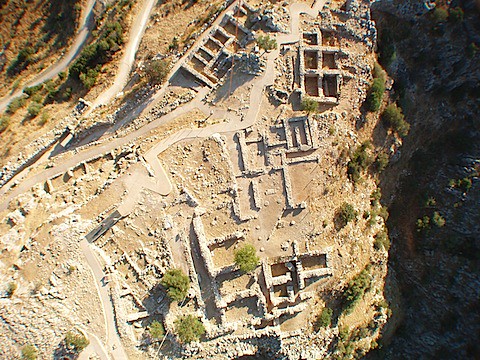
Wednesday, July 16, 2008
More blimp photos
Yesterday morning was a great time for blimpin'. The wind conditions were perfect (none), the light even and the results great. We got a series of photos from the excavation area down the valley including new areas that Christofillis want's to acquire. Below is excavation area showing the architecture and the folks working in the units.
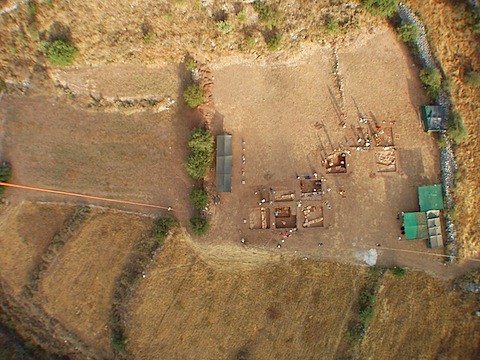
Unfortunately, the afternoon was less successful due to failure of the rig to trigger the camera. We had great shots of the slopes of the acropolis and a large part of the acropolis itself. But no photos. Damn.
This morning, the winds were up and gusty. Since the areas we wanted to cover were close to the acropolis (up wind) there was no way of really flying the blimp. So we bailed and came back down to the hotel for some writing time. We are hoping to put together a list of projects that would be integrated into the collaborative teaching class this fall/spring and then lead to student projects in the summer.
Monday, July 14, 2008
Field Photos
Spent the day working on the blimp. Oddly, the blimp didn't have much lift today. I suspect this is because of the heat of the sun warming the air so that it is less dense and thus lowering the helium effect. But it seems about as hot as it was in Guatemala, so I am not sure. The weight of the rig is the same as it has been, so its not a problem with the payload. Tomorrow, we will start flying the blimp @ 6:00 so we can get cooler air. Perhaps that will help. We really need to get this much higher. I also will use the .5x wide angle lens. That should help significantly but not add any weight.

Another issue is the picavet system -- when the blimp is floating in no wind and the camera hangs straight up and down, the rig tends to be tilted. I am not sure how to fix that yet - it causes spin as well. You can see a bit of the tilt here in the photo above. 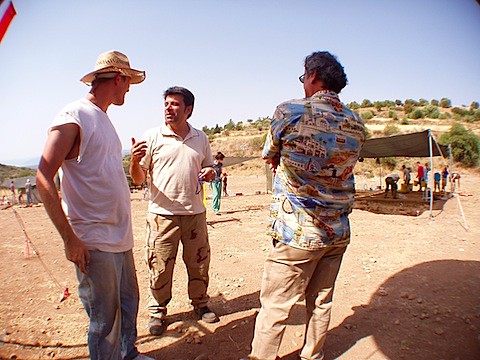
Above: Will Gilstrap (CSULB grad student), Christofillis Maggidis (Director, Dickenson College) and Paul Scotton (Director of Hellenistic excavations, CSULB). For the record, Paul is wearing a Huntington Beach Hawaiian shirt. Will is wearing a hat he found in the trash.
The day ended on a bit of a bummer note when an unnamed (yet pictured above on the left) person opened a freezer (yes, there is a freezer at the excavation site!) and ripped a large gash in the blimp. We repaired it in the afternoon using gorilla tape from a remarkably prepared graduate student named Joe. Hopefully, that will enable us to fly this morning (its 12:30 AM right now).
Mycenae - First Blimp Mosaic
Flew the blimp today and took some photos of the excavation areas that are in work this summer. This is the new "lower town" that was identified via aerial photos, gpr and magnetometry. The walls are just centimeters below the surface -- all Helenistic stuff. The bronze age material is below that. Here's the first mosaic from this morning's work. We will be doing more tomorrow morning (early, 6AM) and then up to the citadel on wednesday. There is a japanese news crew here so I suspect they will love the blimp.

Saturday, July 12, 2008
Mycenae, Greece
Made it to Mycenae yesterday after a long-ass flight from JFK to Athens. The allure of international travel is truly gone - that was an 11 hour domestic flight with the same # of amenities (none) and leg room (equally lacking). Oh well. We arrived in the airport, zoomed through customs, and met a taxi guy who drove us down to Mycenae. Why are taxi's in european countries usually in car brands that we can't afford in the US-- this was a mercedes benz, like most of the taxis around here. Sweet ride.
Got to the hotel and I passed out. I probably shouldnt have but I just couldnt keep my eyes awake. Forced myself to get up around 6 and went to find the students and other CSULB folks. We drank some beverages, ate some pork, pita and tzatziki (and terrific greek salad) -- then I passed out. I woke up at three but forced myself back to sleep (well,that wasn't really that hard). Got up at 7 and ate some bread, drank coffee, and began the day..
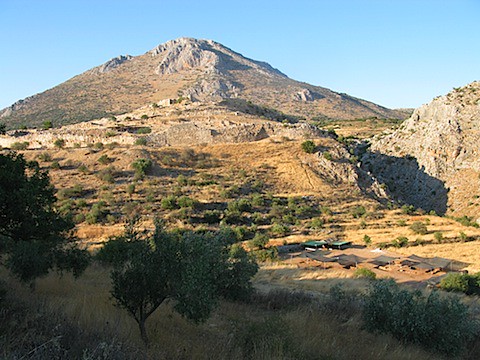 View of Mycenae acropolis and the new "lower town" excavations below.
View of Mycenae acropolis and the new "lower town" excavations below.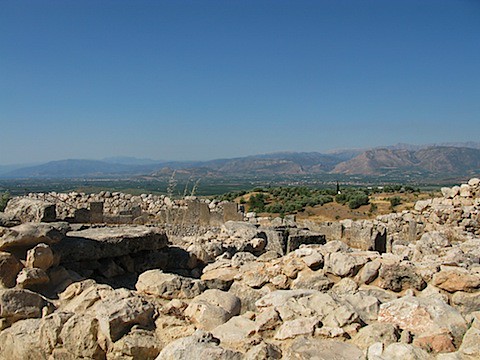 View across the plains...
View across the plains...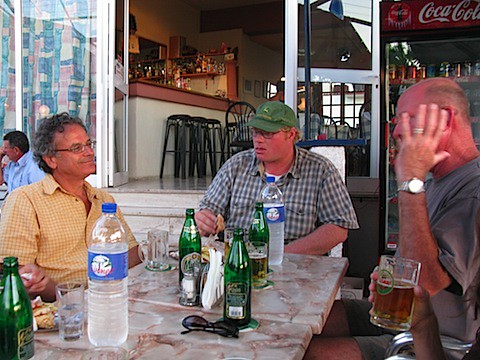
drinking greek bear with chris lee, paul scotton, and leo.
Friday, July 11, 2008
Off to Mycenae, Greece
Got up hideously early to catch a plane to Athens this morning (n.b. why do you "catch" a plane when you've booked it weeks in advance, have at the airport hours in advance, sit waiting to let you board it, and then it sits there for what seems like hours more before leaving? Planes seem to catch us more than anything. I suppose for argument sake this word comes from jumping into a trolly ("catching it") and maybe once upon a time one was able to look at a schedule and speed to the airport in the nick of time to duck in the door before the air hostess closed it [just before serving the fresh lox, orange juice, bagels and coffee)]. I really find no pleasure in getting up at those early hours - despite the cultural pressure (or maybe its just the crap I read) to "enjoy the quiet early hours before the hubbub of the day..." Anyways, its not for me - let me sleep.
The plane to Atlanta is full to the gills, folks are stacked in here like one of those japanese hotels where they slot you into a drawer. Except for here, of course, you dont get to stretch your legs out and the seats make it impossible to fully open a laptop (i have mine tilted at some crazy upward angle so I can reach my fingers around the case to type). Ah, the joys of travel and the jet set. Cattle cars of the air. Moo.
Monday, July 7, 2008
Morning at Seal Beach...
A break from the story... here's a view from the parking lot at Seal Beach in the morning, with surfers lined up across the shore waiting for their sets to roll in. A perfect morning in SoCal
. 
Saturday, July 5, 2008
Advice to Archaeology Graduate Students
I just finished reading Anthony Bourdain's wonderful book, "Kitchen Confidential" that describes his life in the world of cooking and his take on being a professional cook. Given his interest in straightforward hardwork and dedication to the craft of food, his words are inspirational for anyone who strives to be a professional. Bourdain is honest - he knows he doesn't have what it takes to be a 3-star chef. There are culinary geniuses out there that Bourdain recognizes and reveres, but he doesn't count himself as one of them. Bourdain greatness is not in poofy, foamy, arty stuff - but honest good food (the ingredients (the nasty bits), the mechanics and the tastes). This is what makes him what he is: integrity, demand for honest work, and insistence on a good product. He takes no prisoners in this approach and doesn't suffer fools easily. It's a great read.
It occurred to me as I read the book that what Bourdain was describing was a work ethic that resonates well with anyone striving for professionalism. As an advisor of students, most of my work is to get them to work towards the high mark of professionalism. This doesn't mean I necessarily expect them to reach that point - hell, they are students and thus learning (and making mistakes) is part of the process of becoming a professional. That's the point of being in an educational program -- to learn how to be a professional. My job is to demand this standard - consistently - and to provide feedback as to how what may be currently a pile of crap can be transformed/reworked/amended/restarted/scraped/changed into something that is a professional product. And this doesn't apply to just writing a paper - but to learning how to think like a professional, talk like a professional, dress and act like one. On the thinking end of things, one must demand critically sharp logic. When speaking or writing, choose one's words carefully and make sure they mean the same thing every time you use them. These kinds of lessons are basically the bread and butter of being a professor - what makes students turn from slouchy mumblers with a glint of potential, into polished scientists capable of rendering any problem into a series of logically related concepts and solutions.
In one of the latter chapters of Kitchen Confidential, Bourdain writes about a commencement address he would give (or perhaps has given) to culinary students upon graduation. The points he lists are remarkably applicable to graduate students. With recognition of Bourdain's initial formulation, I list them here modified to address the basic principles of professionalism for archaeology students wanting to enter graduate school.
1. Be fully committed.
If you are not fully committed to becoming a professional archaeologist and keeping your eye on that goal, just pack it in right now and get an MBA, learn genetics, or take up programming. Don't even think about starting graduate school in archaeology if you are instantly repulsed by the idea of sitting in a crappy classroom at 2:30AM on a thursday night measuring projectile point lengths for the 50th time to generate error terms while your bank account hovers near zero, your debt climbs faster than the kudzu, your partner hasn't seen you in 6 months, your car has 12 parking tickets and the paper you need to work on and submit by monday is still a glimmer in your brain. This is what will happen - count on it. The lucky (and by no means smarter or more talented) few who get scholarships and the like don't always become the best archaeologists. If its too easy, it probably is. If you aren't struggling to change the way you think and do work, then the program you are in sucks. Pack your bags and find and leave immediately. Find another program. The fact is that anyone taught that archaeology is easy or that we are just "dangerously close to science" doesn't deserve to teach archaeology. We are talking about the science if history here, man! It had better be damn hard if we as a species can manipulate the basic elements of matter and yet have failed at building a science of our own fate. It's certainly not for the lack of trying. So if your brain isnt spinning for the first decade of studying this stuff - you just aren't being taught well. Suffering in graduate school isn't about suffering per se - but about committing your life to becoming a professional. Lots of things that you once believed were necessary or essential (friends, money, good food, leisure time, new wardrobes, vacations) will be stripped away. Now this doesn't mean that one must take a life of a monk to be a professional in archaeology - it just means that when you need to do something, you will be completely, utterly, absolutely committed to doing it.
2. Learn to write, speak and think.
Don't assume that because you were able to squeak good grades out of your papers in undergraduate that you know how to write. Also, don't assume because you can order chicken from a car window, that you can speak. Same goes for believing that are a critical thinker because you think you are smarter than the average bear: everyone believes that so it can't true. Committing to becoming a professional means that you need to start taking writing, speaking and think very seriously. Your ability to do these things is directly related to your ability to being a professional. Do poorly at any one these things, and you might as well pack it in.
All three of these skills are obviously linked. But being able to do one doesn't mean that you can automatically do the others. And you can't skimp on any of them. Attempting to discuss issues with speaking skills that are filled with "uhs, ums" and ad hoc statements will quickly get you ignored. Don't even think about using the word "like" in your sentences. Speak in full sentences - have those sentences form full thoughts that are linked together. The same goes for writing. All of this about building up your logic skills. Learn to take a premise and then break it down. What must necessarily be true if the statement you or someone else has just said is to be believed? Are statements and assumptions logically connected? If not, why? Treat everything you write as a geometric proof. Assume nothing - be explicit. Define your terms.
Reading how to write is a good first step. I recommend Zinseer's book: "On Writing Well". Practice a lot. Practice writing out your ideas. Practice talking with your colleagues. Practice, practice, practice until logic in your writing, speaking and thinking is second nature.
3. Be open, sharing and honest.
In academia, ideas form the basic currency. One might imagine that hoarding ideas might be a good practice in order to "protect" one's assets. Nothing can be further from the truth. Ideas have no value unless shared. Share your thoughts, schemes and ideas. Once you are learning to think you should find yourself overwhelmed with ideas about dimensions of problems that you think you can resolve. Share those -- surely you don't have enough lifetimes to do it all yourself? Create a community of ideas around yourself with your friends and colleagues. The interchange is more valuable than the ideas themselves and the greater they are shared the greater the value. Good ideas are always those that are shared.
I have met graduate students and colleagues who walk around tight-lipped about what they are up to and who are afraid to share their work for fear of someone "scooping" them or perhaps demonstrating why what they are doing is wrong. Dumb-asses, all of them and of very marginal value as colleagues.
At the same time, be honest about where your ideas come from. If you've talked some idea over with a friend, be sure to recognize them. Reference your sources, identify those that share your ideas. While counter-intuitive to the "hoarding" folks, this kind of attribution only strengthens the value of the ideas since these notions aren't something that come of out left-field -but are part of emerging community consensus about the topic. Attribute folks to a fault!
4. Deliver what you have promised on time.
As a student, this is especially important. Don't let your advisor down by not following through on what you have said you would do. This wastes everyone's time and starts a reputation for yourself as being one of those students that talk big, but cannot finish anything. This is not a reputation you want to have since it will follow you throughout your career and will close doors to opportunities you didn't even know you had. If people feel that you are never able to turn a chapter in on time, what's the chance of getting invited to contribute to a volume? While the late papers and incompletes you are doing in graduate school might seem like a minor thing, they are most certainly not. Commit and do what it takes to get your work done.
5. Never make excuses or blame others.
If you screw up, just own up to it. Nobody remembers the occasional mistakes of the person that owned up to them and corrected the error. The person that tries to make his mistake someone else's fault will eventually gain a reputation as being a slippery and untrustworthy character. These folks are the worst because they infect organizations with mediocrity and make others work harder to pull up the slack. Ultimately, no one cares who created a problem -- all that matters is fixing it and preventing it for the next time. If there is a problem, take responsibility for it even if you think it wasn't your fault. Don't wait to point the finger - be the one who is one step ahead.
6. Never call in sick.
Commitment means that you take your work seriously and will do whatever it take to get it done. Unless blood is pouring down your face, get your work done. And if blood is pouring down your face, get some stitches so you can return to getting your work accomplished.
7. Lazy, sloppy and slow are bad.
Becoming a professional means that you take everything you do seriously and the point is creating a solid, meaningful product not just getting the work done. Those who see archaeology as simply a means to an end are not committed to what this is all about. Commitment means that you take whatever step necessary to make sure what you produce is really what you say it is. This means independent measurements.. lots of independent measurements. This mean development strategies for evaluating your work as you are doing it rather than piling it up and hoping that you generated what you think you generated. Be careful and deliberate in your recording of information - make everything you do instantly understandable by other people. Do not drop out details. Record everything.
As for slow being bad - I mean that in the sense of get stuff done. Generate your data and get it summarized and into some analysis as soon as you possibly can - sooner even. Never let things linger or put off doing what you need to do until "some other day."
8. Be prepared to witness every variety of human folly and injustice.
People are sometimes very bizarre and when you're thrown into a pressure-filled situation weird things happen. Graduate school is filled with freakish people and even freakier faculty. Field, lab and class situations can mix together every sort of individual in remote, difficult or crazy locations. Be ready for this and don't get sucked into the personal ego battles. Keep focused on why you are doing what you are doing: to learn how to be a professional. Don't whine about how some individual is being paid more than you though with less experience, Don't go on about your need to get your turn on some piece of equipment. Who cares? Focus on whatever you are doing and do the best possible job at doing it.
9. Assume the worst.
Bourdain warns that you must be careful to not let this seemingly negative outlook poison you. You need to think of this piece of advice as developing the ability to realistically calibrate your expectations of people and situations so that when things get messed up you aren't so surprised that you can't function effectively. Be ready to deal with broken computers, fail lab results, exploding printers, crazy colleagues, demented faculty and the like. These are just the cost of doing business.
10. Avoid advisors who insist on being first authors on papers they do with students.
Faculty who have tenure should be in the game to promote their students not promote their own, increasingly crappy, work. Faculty who continue to publish first author articles that are based on student work think far to highly of themselves and not highly enough for their own students. Who cares if some senior faculty adds another article on to their resume consisting of 140 entries? What difference does that make to anyone other than the advisor's ego? A student, on the other hand, really benefits from the article AND the association with the supposedly big name advisor.
You might even want to extend this point by avoiding advisor's who are pre-tenured altogether. Usually they are so focused on their own success they will have little time for students other than using them to generate results to pad their resumes. They also typically have no experience being an advisor and will likely have no idea what to do. Pick an advisor who has experience and has produced quality students that you can evaluate. Forget the newbies until they ripen a little more.
11. Think about that resume!
Everything you do should somehow be adding to your resume. Figure out how to take class papers and projects and turn them into something you can present at a local meeting (or national! thing big!) or produce as a published paper. Jump at every opportunity to gain experience whether paid or unpaid. Too many students cannot see that the plethora of instruments, talent, knowledge and projects that are available at most universities are a treasure chest to plunder. Don't expect to get paid - do everything for your future. Learn everything, get experience in as many dimensions as possible. Volunteer. Do whatever it takes to get involved in as many projects as possible.
12. Read!
While this point might see obvious, it is something that many graduate students forget: they read the required reading and then stop there. No matter how massive a reading list or bibliography might be, the volume of archaeological literature that is available for any topic is nearly inconceivably large. Never stop with the required readings -- what are the readings upon which those readings are based? What has happened since the articles were published?
Subscribe to the table of contents services for every journal you can think of - go far beyond archaeology journals and look at science, engineering, evolution, biology, genetics, material science and so on. All of these disciplines intersect archaeology one way or the other - and you need to know about them. In fact, most of the best literature out there isn't published in archaeology - in fact it rarely is: most stuff archaeologists do is crap. So, never stop exploring - be a master of everything. Use RSS lists to keep track. Send interesting things you find to your colleagues - trust they will do the same.
Don't just look at the titles, too. READ the articles you collect. Set aside a chunk of time everyday where you read. Never stop reading.
13. Never stop learning.
One can always spot the archaeologist who has just given up and simply rehashing the same old shit -- they've stopped learning and are no longer able to generate new ideas or conceive of the world in ways other than the way they were taught back in their graduate career. These folks are relics - useful reminders of ideas of the past and perhaps repositories of once-current method and concepts. But they are effectively dead. Now this doesn't mean that you should leap onto whatever archaeological bandwagon happens to be passing by -- the majority of them are rickety death traps driven by hucksters and carpet baggers. Your learning should build on what you know (assuming you had good graduate training in the first place and actually learned something useful). Keep adding to your knowledge, challenging your ideas and looking for inspiration. This is the mark of the professional - never satisfied with the product and always looking for improvement.
14. Don't forget to have fun.Being professional doesn't mean being dour and overly earnest. In fact, folks who confuse dour and earnestness with professionalism are some of the saddest cases of academics I've ever seen. The SAA meetings are chock full of these folks - solemnly carrying their slide deck around with furrowed brows and steadfast determinism. It's almost as if that they believe that if they take themselves really seriously, then everyone else will too. This is usually a bad sign - the ideas may be serious, but you don't have to be. In fact, being serious tends to inversely correlate with serious ideas. I mean, how can one possibly get all worked up about research claiming that small shallow pits are excavated by children while deeper ones are excavated by adults?
So, have fun - take your work seriously, not yourself.
Thursday, June 26, 2008
LMV 2008 Survey
You can view all of our photos from the LMV 2008 Survey by downloading:
http://www.csulb.edu/~clipo/LMV/LMS-Survey-2008.kmz
You might also try:
http://www.csulb.edu/~clipo/LMV/LMV-Survey-2008.kmz
and opening the file in Google Earth.

Tim hanging out at Blues Alley...
Monday, June 23, 2008
New Orleans...
beans and rice, and oysters at Mulato's....


